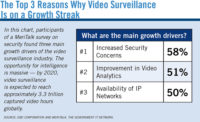Why HDoC Is a Compelling Alternative
Cost savings, convenience and capabilities propel HD-TVI and HDCVI to the top of the HD-over-coax hill.

Looking at a side-by-side comparison of 720p HD over coax (top) and analog video, the benefits of technologies that transmit IP-quality video over legacy infrastructure are clear to see. IMAGE COURTESY OF SECURITYTRONIX

While HD-TVI and HDCVI are very similar and offer significant performance benefits compared with analog HD (AHD), there are a few key differences between the two, particularly depending on the type of cabling used. TABLE COURTESY OF DAHUA TECHNOLOGY USA


As the industry increasingly moves toward adoption of IP-based video, which continues to outpace analog every year, there is still a large portion of end users who continue to rely on their legacy systems. When these customers weigh the pros and cons of higher quality and greater functionality IP video offers versus the cost, they come to the conclusion that their analog video system is “good enough.”
In many cases, this hurdle can be overcome easily, allowing end users to take advantage of HD video using their existing coax cabling. Offering a compelling alternative that bridges the gap between traditional analog and IP systems, HD over coax (HDoC) systems deliver megapixel video over legacy infrastructure and, generally speaking, are less complex to install and operate than IP solutions.
Since the introduction of analog HD, a number of formats have emerged, including high-definition serial digital interface (HD-SDI), analog HD (AHD), and most recently HD transport video interface (HD-TVI) and HD composite video interface (HD-CVI). Long the leader in HDoC, HD-SDI has fallen by the wayside recently because of performance limitations. At the moment, there is no clear frontrunner to succeed HD-SDI as the standard or de facto format in this space. However, by many accounts, both HD-TVI and HDCVI are well-positioned to take the crown.
At the basic level, HDCVI and HD-TVI both convert digital images of up to 1080p resolution into signals that transmit over long distances — up to 1,700 feet — over coax cables. According to Aaron Starr, president, SecurityTronix, West Chester, Pa., both are also in the process of adding control over coax (CoC) capability, which would make them even more cost-effective solutions for migrating from analog to IP.
Both HDCVI and HD-TVI are proprietary technologies that are licensed to manufacturers. In general, camera resolutions currently range from 1 megapixel to 4 megapixels and increasing over time. For example, in 2016, Dahua Technology released HDCVI 3.0, which added support for 4K or 12 megapixel video over coax. Regardless of resolution, says Mike Tabola, senior product manager, Johnson Controls Tyco Security Products, Westford, Mass., these two formats hold their own against network cameras.
“Video quality is comparable with what can be achieved with IP-based technology,” he says.
One potential downside of both HDCVI and HD-TVI is the need to use compatible recording technologies.
“An HDCVI or HD-TVI recorder is needed to interface to the cameras; these recorders typically support standard-definition cameras and in many cases IP cameras also,” Tabola adds.
According to Jennifer Hackenburg, senior product marketing manager, Dahua Technology USA, Irvine, Calif., HDCVI has been designed to incorporate multiple HDoC formats in an effort to be more attractive for end users looking to make the move to IP.
“HDCVI technology also features penta-brid digital video recorders and 2MP multi-analog format cameras for applications that require the mixing and matching of competing HD over coax standards such as AHD and HD-TVI,” she says.
For increased data security and oversight, HDCVI can be monitored remotely via a software app, PC software or Web interface. Both formats offer increased data security compared with IP-based video systems because data is transferred over coaxial cable rather than the network, she adds.
What’s the Difference?
If you’re thinking that these two HDoC technologies sound like one and the same, you’re not alone. And you’re not wrong because for the most part, HD-TVI and HDCVI are virtually the same with a couple of notable exceptions.
“We have not discovered any material differences except for the fact they are not interoperable,” Starr says.
Another distinguishing characteristic is the way in which they operate with other technologies, which affects how each standard is made available to manufacturers.
“There are virtually no differences other than the difference in frequency which causes them to be proprietary,” says Greg Bier, director and CEO, Vitek Industrial Video Products, Valencia, Calif.
Supported resolution is third key difference between the two, as evidenced by Dahua’s support for 4K video, Hackenburg says.
“This 4K offering represents the highest imaging available for coax infrastructures — delivering four times the resolution as 1080p,” she says. “Additionally, HDCVI offers mid- to long-range 4MP PTZs, where HD-TVI and AHD only offer up to 2MP PTZs.”
For the most part, however, the differences between the two are either marginal or subject to individual interpretation, Tabola says.
“Obviously the protocols between the two technologies are different and there may be some differences in the distance limitations that video can travel over coax, but this would be minor,” he says. “There may be slight differences in video quality but this is subjective based upon the deployment application and individual preference.”
Who’s on First?
With so few significant differences between HD-TVI and HDCVI, the obvious question becomes whether one format is more widely adopted than the other and if so, why? Not surprisingly, the answer depends on who you ask.
Starr and Bier, whose companies — SecurityTronix and Vitek Industrial Video Products — offer cameras using both formats, fall on the HD-TVI side.
“TVI is more common because CVI was developed by one company — Dahua — but TVI was developed by a non-biased entity named Techpoint and licensed to many brands,” Bier says.
“We have found TVI to be more requested than CVI in our sales, but we can’t speak for other brands,” Starr says.
Also backing HD-TVI is Lou Bellock, product manager – hardware, for Hikvision USA and Canada, City of Industry, Calif., which played a key role in the development and release of the technology.
“We believe HD-TVI is becoming more popular because of its advantages over HD-CVI which include: overall image quality, latest compression technology, H.265+ and greater transmission distance,” he says.
On the HDCVI side is Hackenburg, whose company Dahua Technology USA developed the technology in-house.
“The standard is used by more than 200 companies, including Dahua’s competitors, elevating it to the more widely used HD over coax standard in the industry,” she says. “Having built HDCVI from the ground up, Dahua has more control over the development cycle for introducing new iterations of the technology.”
What Should You Be Doing?
Regardless of which technology you choose, the primary benefit is the ability to deliver HD video without ripping and replacing an end user’s existing coaxial infrastructure. Therefore, potential sales opportunities should be obvious to integrators, Starr says.
In addition to cost-effectiveness, transmission distance is another factor that makes HD-TVI and HDCVI an appropriate path to migration for many users. However, Bier says, even these two formats have distance limitations.
“Since they are analog signals, they are fairly forgiving as to the cable characteristics and twisted pair baluns that can be used. However, the analog signals degrade over distance, so that is a drawback,” he says.
On top of the benefits for end users, HD-TVI and HDCVI also create opportunities for installers who may lack the solid skills needed to truly succeed with IP-based systems.
“For integrators that have experience in deploying CCTV networks using coax, these technologies allow them to compete with IP-based systems. Little, if any, IP networking experience or knowledge is needed to install a system, which in many cases simplifies the installation,” Tabola says.
Ease of installation is a hallmark of HDoC, and while HD-TVI and HD-CVI solutions may be just like deploying analog systems, there are still important considerations for integrators, Bellock says.
“Integrators should know that it’s just like traditional analog; it’s as easy as traditional analog. The only thing need integrators need to watch is if they go over twisted pair fiber. In that case they need to upgrade to higher bandwidth baluns or fiber transmitter receivers, because of the higher bandwidth of the signals,” he says.
Defining the Formats
HD-TVI
Released in 2014 to overcome the distance limitations and other challenges of the previous HD-SDI (serial digital interface) format, high-definition transport video interface (HD-TVI) was developed by Techpoint and later sold to Intersil. HD-TVI cameras currently support 1080p video resolution over coax, offer extended transmission over both RG-59 and CAT5 cabling with minimal or no signal degradation. The format allows users to connect to any analog, HD-TVI or even IP camera on any DVR channel, and requires much less storage capacity than IP-based systems.
HDCVI
Built from the ground up by Dahua in 2012, high definition composite video Interface (HDCVI) is a proprietary HD over coax format capable of transmitting 4 megapixel/1080p video up to 500 meters over RG-59 cable with no latency, stretching or distortion. In 2016, Dahua released HDCVI 3.0, which added the ability to transmit 4K (12 megapixel) resolution video over coax.
Looking for a reprint of this article?
From high-res PDFs to custom plaques, order your copy today!











